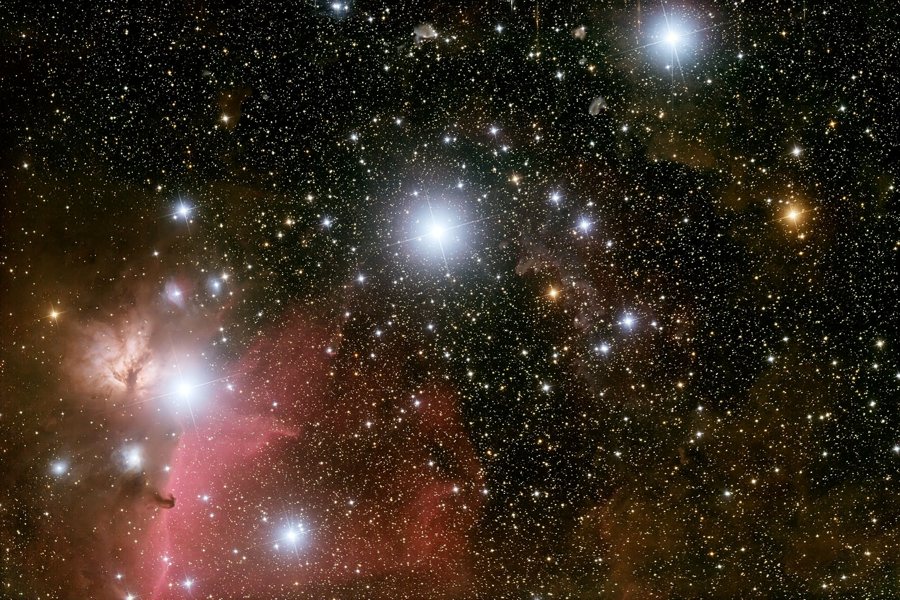That's a fine picture, and I like it.
APOD Robot wrote:
This colorful rendition of part of the constellation of Orion comes from red light emitted by hydrogen and sulfur (SII), and blue-green light emitted by oxygen (OIII).
Orion Nebula in OIII, Hα, SII. Photo: Robert Fields.
There is certainly a lot of red light in today's APOD, much of it from rather low-level ionization SII. By contrast, there is not much blue-green color at all, and it is only found in the Orion Nebula.
But today's APOD doesn't look much like a mapped color image in the first place. Compare the appearance of the
Running Man nebula in David Lindemann's APOD with the appearance of it in Robert Field's mapped color image. In Robert Field's image, the Running man nebula (at 9 o'clock) looks yellow from hydrogen (green) and sulfur (red), but in today's APOD it looks blue and pink, as it would in a visual light image. The blue color of the Running Man nebula certainly has nothing to do with OIII emission, but is caused by dust grains reflecting the light of a partly embedded spectral type B2 star. Such stars are not hot enough to produce OIII emission.
Robert Field's image gives you a good idea of where to expect OIII emission in and around the Orion Nebula.
M78, reflection nebula in RGB.
Photo: Ian Sharp.
There is quite a lot of blue in today's APOD that has nothing to do with ionized oxygen at all. One of the brightest reflection nebulas in the sky is M78, which shines by reflected light from an embedded B-type star. The nebula, seen at 8 o'clock in today's APOD, looks blue from reflected light.
Orion's Belt is surrounded by a lot of blue light in today's APOD. I think it is true that there may be reflection nebulosity here, but I doubt there is OIII in that vicinity. And the enlarged image of today's APOD shows a lot of blue light surrounding Rigel. Rigel is a rather cool B-type star, and it isn't able to ionize anything whatsoever. But it is indeed surrounded by a reflection nebula.
Finally, is Barnard's Loop a supernova remnant? The abstract that the APOD link leads to reads in part like this:
We have supplemented existing spectra of Barnard's Loop with high accuracy spectrophotometry of one new position. Cloudy photoionization models were calculated for a variety of ionization parameters and stellar temperatures and compared with the observations. After testing the procedure with recent observations of M43, we establish that Barnard's Loop is photoionized by four candidate ionizing stars, but agreement between the models and observations is only possible if Barnard's Loop is enhanced in heavy elements by about a factor of 1.4. Barnard's Loop is very similar in properties to the brightest components of the Orion-Eridanus Bubble and the warm ionized medium (WIM).
I take this to mean that there are four stars in Orion that ionize Barnard's Loop. (These stars might possibly be Alnitak and Iota Orionis, and also possibly Sigma Orionis and... Alnilam? Mintaka? Isn't Theta Orionis Ic too young to have had such a large-scale effect on its surroundings already?)
But Barnard's Loop is enhanced in heavy elements in a way that makes it similar to the Orion-Eridanus Bubble.
Wikipedia wrote:
The Orion–Eridanus Superbubble, or Eridanus Soft X-ray Enhancement is a superbubble located west of the Orion Nebula. The region is formed from overlapping supernova remnants that may be associated with the Orion OB1 stellar association; the bubble is approximately 1200 ly across.[1] It is the nearest superbubble to the Local Bubble containing the Sun, with the respective shock fronts being about 500 ly apart.
I take this to mean that Barnard's Loop is not
a supernova remnant. Rather, it contains material from previous supernova explosions, and its structure might have something to do with shock fronts from previous supernovas.
Ann
 Orion in Red and Blue
Orion in Red and Blue


